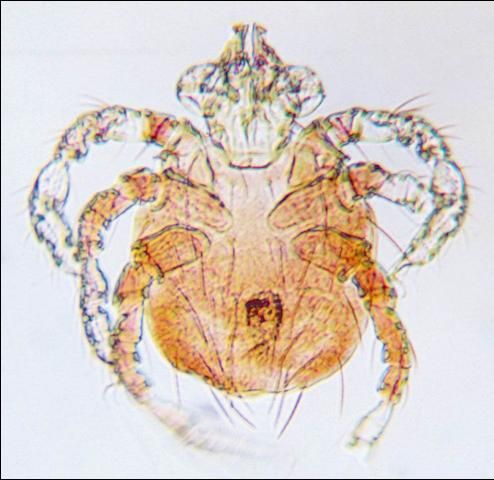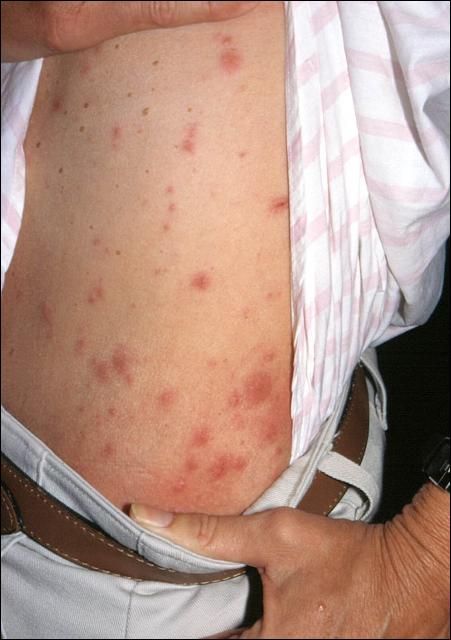
Credit: UF/IFAS
Chiggers (Figure 1), or "red bugs", are the larvae of mites belonging to the family Trombiculidae. In humans, chiggers can cause intense itching and small reddish welts on the skin. An infestation like that is called chigger dermatitis or trombiculosis. The intense irritation and subsequent scratching may result in secondary infection. In other parts of the world, chiggers transmit scrub typhus; however, in Florida they are not known to transmit any human disease agent.

Biology
The life cycle of chiggers is divided into five main stages: egg, prelarva, larva, nymph, and adult. The females lay eggs in a sheltered area. The eggs hatch into the prelarva, which is inactive and does not feed. The larva is the parasitic stage that feeds on humans and animals. The orange-yellow or light-red larval, six-legged stage crawls on the soil surface until a suitable host is found. Suitable hosts range from small mammals to birds, reptiles, and amphibians. Humans are accidental hosts. Chiggers that attach to humans are usually dislodged or die within hours.
The larvae suck fluids from the skin of the host animal and do not burrow under the skin. Usually within three days the larva is engorged. The larva then drops from the host to the ground and transforms into the nymphal stage.
The nymph, like the adult mite, has eight legs. The body is usually hairy and about 1/20-inch (l1.3-mm) long and bright red. The nymphs and adults feed on insect eggs, small insects, or other organisms. Adult chiggers usually overwinter in protected places and become active in the spring, although is South Florida they may be active all year.
The entire life cycle can require from two months to one year. As many as one to five generations may be produced per year depending on the temperature, moisture, and location.
Chigger Bites
Chiggers attach themselves to the skin, hair follicles, or pores by inserting their piercing mouthparts. When chiggers attach to humans, they are not usually noticed for some time. During feeding, they inject a fluid into the skin, which dissolves tissue. Chiggers feed by sucking up the liquefied tissues. They do not feed on blood. They specifically feed on partially digested skin cells and lymph broken down by their saliva. The human immune reaction to a bite prevents the chigger from obtaining adequate nourishment. They rarely survive long enough to complete a meal.
Itching from chigger bites is usually noticed four to eight hours after chiggers have attached or have been accidentally removed. The fluid injection causes welts to appear, which may last for two weeks (Figure 2). Some people exhibit an allergic reaction to the fluid, which may result in severe swelling, itching, and fever. People mistakenly believe that chiggers embed themselves in the skin or that the welts contain chiggers. Often scratching at the welt results in secondary infection.

Chiggers prefer to attach on parts of the body where clothing fits tightly or where the flesh is thin, tender, or wrinkled. For this reason, chiggers locate in such areas as the ankles, waistline, knees, or armpits.
Preferred Habitat
Chiggers are most often found in low, damp areas where vegetation is heavy, although some species prefer dry areas. Chiggers seem to be most abundant in areas covered with shrubs and small trees where rodents are numerous. Chiggers occur in pockets or islands because a female lays all her eggs in one spot. However, chiggers may persist in home lawns.
Control
Chiggers are easily removed from the skin by taking a hot bath or shower and lathering with soap several times. The bath will kill attached chiggers and others that are not attached. Since symptoms of contact may not appear for several hours, it is not always possible to completely prevent welts caused by chigger bites. Antiseptic should be applied to all welts that do appear. Temporary relief of itching may be achieved with nonprescription local anesthetics available at most drug stores. Studies have shown that meat tenderizer, rubbed into the welt, will alleviate itching.
If you are going into areas suspected of being infested with chiggers, wear protective clothing and use repellents containing DEET (N.N-dimethyl-3-benzamide). Repellents should be applied to the legs, ankles, cuffs, waist, and sleeves of clothing or directly to the body as directed by the label.
Chigger infestations may be eliminated through habitat reduction. Frequent mowing of lawns and clearing shrubbery and weeds removes the protective cover that chiggers need to survive. To locate infested areas, place a piece of black cardboard edgewise on the ground. If chiggers are present, they will climb to the top and congregate there. They will appear as tiny yellow or pink dots moving across cardboard. Before starting your survey for chiggers, use protective clothing and repellents.
Area control of chiggers is difficult to achieve. However, a wide variety of insecticidal products are available such as synthetic pyrethroids or carbamates. Apply these chemicals as directed on the label, and avoid getting insecticides into ponds and streams.
Also, attempt to exclude reptiles, amphibians, and small mammals that are preferred chigger hosts from the areas you will frequent. In some cases, fencing may be an option. Keep trashcan lids secure to discourage unwanted wildlife from roaming your premises.
Chiggers sometimes invade structures. These infestations can be controlled with either surface or crack-and-crevice treatments of insecticides or space sprays.